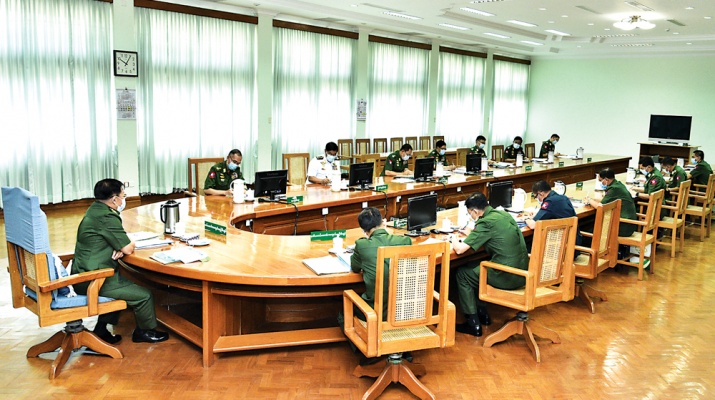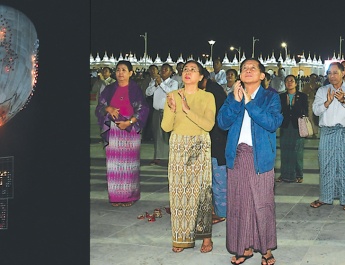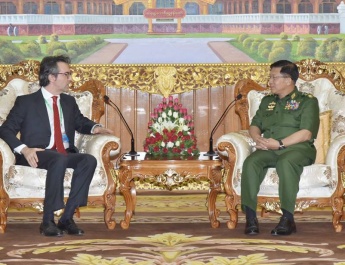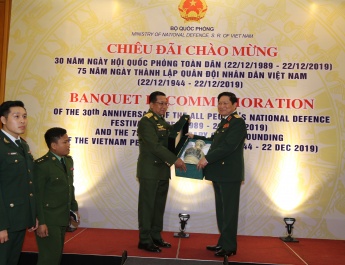Nay Pyi Taw May 21
The seventh meeting to prevent and control COVID-19, treat patients and provide other necessary requirements was held at the Office of the Commander-in-Chief (Army) here this morning, under the leader-ship of Commander-in-Chief of Defence Services Senior General Min Aung Hlaing.
Present at the meeting were Senior General Min Aung Hlaing, Deputy Commander-in-Chief of Defence Services Commander-in-Chief (Army) Vice-Senior General Soe Win, Union Minister for Defence Lt-Gen Sein Win, Chief of the General Staff (Army, Navy and Air) General Mya Tun Oo, Commander-in-Chief (Navy) Admiral Tin Aung San, Commander-in-Chief (Air) General Maung Maung Kyaw and senior military officers.
In his keynote address, the Senior General said Myanmar has 199 positive cases, 108 recovered cases and six deaths since COVID-19 was tested positive in the country on 23 March. In the 215 regions of the world, there are over 5.07 million positive cases, over 320,000 deaths, and over 2,006,000 recovered cases till today. Although it can be said that certain countries like New Zealand and Cambodia can control the virus, they are not totally free from it. Myanmar’s capacity to conduct test is still small. So, people should not reduce their degree of awareness.
Because of the virus, labour, capability and efficiency of the infected persons and health staff who are treating them, volunteers and their families fall, and it has impact on the strength, production, economy, social status and per capita income of the country. Some countries face a new wave of infections after relaxing the restrictions. So, all must have attentiveness in every action.
The Tatmadaw is taking all necessary preventive and containment measures against COVID-19 on a national scale. In carrying out prevention and containment undertakings for the people, the Tatmadaw never leaves out EAOs including UWSA (Wa) and KIO/KIA as they too are the ethnics of Myanmar. The Tatmadaw is also conducting COVID-19 prevention and containment in Rakhine State, as it has the duty to solve the problems of the people and save them from hardships. The Tatmadaw will serve as the protector and the light for the people in accord with the military codes of conducts. Protecting the strength of the country and the people is its political and national cause. It will continue to serve all its duties.
Participants then explained the endeavours of the COVID-19 emergency control and response committees in regions and states, COVID-19 infection in global countries, ASEAN countries and neighbouring countries, testing of 3,027 persons with Rapid Test Kits, 364 with PCR and 754 with Cobas 6800 at military hospitals and medical battalions till 20 May, the negative test results of an infected Tatmadawman who recovered from the virus and the quarantine programme, the supply of reagents required in the tests conducted by PCR and Cobas 6800 analyzer, negative results of the health test on officers, other ranks and families of the Office of the Commander-in-Chief (Army), priority programmes to test officers, other ranks and families of military commands based on the infection rate.
The reports highlighted No 2 team formed by the Medical Services of the Tatmadaw on duty of medical treatment at the Central Institute of Civil Service (Lower Myanmar) Hospital after No 1 team has completed his duty, keeping members of medical corps of the Tatmadaw at home stay after giving medical treatment in Tachilek and Tiddim, duty of medical team members assigned at Sagaing Sitagu Buddhist Academy for providing treatment to members of the Sangha and nuns who arrived there in the second batch, sending of medical teams including specialists to Rakhine State, and performing community-based medical checkups on workers of factories and local people in Yangon Region.
They also reported on finding of positive cases in 54 townships of regions and states except Kayah State on 59th day in the ninth week of virus infection in Myanmar, the world’s highest infected situations of the United States of America with more than 1.5 million infected people and over 90,000 dead persons, conditions of New Zealand which firstly found the virus on 28 February and wonderfully controlled the infection for the disease with 1,503 infected persons, 21 dead and 1,447 recovered but six infected people only were found in the 12th week, and control of disease infection in China in banning tourist arrivals, closing all borders and ports in three weeks after finding the disease, keeping all entries to China in quarantine, restricting travels by declaring the state of emergency, ordering the people to stay at home and adopting punishments for offenders so that the people strictly abide by the orders since the virus has been found in Wuhan.
The report was mentioned that the virus was found in Australia on 25 January, leaving 7,069 infected, 100 dead and 6,413 recovered, and number of infected ones declined to 77 in the 17th week. Travel restriction was adopted for the whole country about three months. So, infection was under control and lockdown arrangements were eased step by step.
Some countries early eased restrictions due to declining of infections but infection rate surged up. So, some areas were placed under restrictions again. As Vietnam and Laos can control infection in their countries, schools can be reopened. Although schools in some areas of France where infection rate was down were reopened on 11 May, about 70 infected persons related to the schools were found within one week after opening the school. Hence, schools were closed again.
Although orders and directives were issued in respective regions so as to prevent and control the disease in Myanmar, people are weak to follow the orders and directives. Patients of positive cases were infected the virus via foreign returnees as well as local silent carriers who did not have travelling records and contact with confirmed patients. As monsoon will come soon, symptoms of seasonal flu and dengue haemorrhagic fever are noticeable because these symptoms are slightly similar to that of COVID-19.
They continued presentations that rations were provided to war veterans and families of the officers and other ranks who sacrificed life for the Tatmadaw, and former police members. Donated cash from salaries of Tatmadaw members and substitute-appointed civilian personnel amounted to more than Ks-2.316 billion in April and over Ks-2.159 billion in May. Donated cash in April was spent on three-time donations of hospital equipment at prioritized levels in respective military command areas. A plan is underway to spend one day wage donated in May on hospital equipment for people’s hospitals—30 specialist hospitals, 24 general hospitals, 32 district hospitals, 233 township hospitals, 392 station hospitals and 500 rural health centres—for the first time. In four time donations, hospital equipment was distributed to 1,060 of 1,168 hospitals across the nation, accounting for 99 percent and 1,088 of 1,949 rural health centres, 56 percent. Further donation plans were also presented.
They continued to report on the donation of 32 pieces of medical equipment including 1.5 million masks, 100,000 face shields, 100,000 OT caps, 219 cylinders of oxygen, 30,000 N95 masks, 40,000 sets of PPE, 140 suction machines, 9,505 liters of disinfectant liquid, 2,520 non-touch thermometers, 153,000 pairs of examination gloves, 164,020 pairs of surgical gloves, 70,000 bottles of hand gel, 20,000 goggles, 18,145 boxes of beaching powder, 168 pulse oxymeters, and 14 portable X-Ray machines and 14 ECGs.
The report also centred on giving of health talks in remote areas, donations of medicine and medical equipment in 8,241 villages in respective military command areas, provisions of supplement nutritious foods worth over Ks-82 million for health staff members and patients at 412 people’s hospitals in respective military command areas, transport of medical supplies by Tatmadaw aircraft and helicopter and preparations for use of military ships as hospitals.
They also reported on functioning of factories under Myanmar Economic Corporation and Myanmar Economic Holdings Ltd in line with the guidelines, manufacturing of protective equipment for spraying disinfectants and hand sanitizers in support of COVID-19 prevention and production of PPEs in accord with bio safety level. The Senior General attended to the needs.
Speaking on the occasion, the Senior General said plans must be made for students in the military units to review they have been taught before schools reopen. Reading corners must be arranged for a group of 10 for about two hours a day. Time can be spent effectively by conducting cultural courses such as 38 kinds of auspiciousness based on social ethics.
As monsoon rain starts to come and sunray course falls on Myanmar, rain and sunshine occur alternatively causing the likelihood of flu, DHF, malaria and COVID-19 outbreaks. So, greater care is necessary. One can work only one is healthy. As body immunity contributes to disease resistance, all trainees, officers and other ranks and their families need to eat nutritious food and stay healthy.
For COVID-19 testing, the units and regiments in most COVID-19 affected townships must be prioritized. Since health workers need to be skilled, discussion and training are always necessary. All service personnel must be proficient so that every Tatmadaw hospital can meet the prescribed norms and standards including cleanliness.
As prevention is the best way to deal with COVID-19, personal hygiene and sanitation, wearing face masks and goggles for eye protection, washing hands and keeping them in dry and clean conditions and going out with caution only when it is inevitable with the minimum number of people within the shortest period are essential. New Zealand and Australia are enjoying the benefits of relentless efforts to observe strict rules and disciplines. It is impossible to refuse to accept the expats who return from other countries as they face difficulty there since they are citizens and it is necessary to find out the best ways and means to prevent and control COVID-19 in repatriation.
As the Tatmadaw has carried out its own agriculture and livestock breeding tasks systematically and energetically, it can not only fulfill the need of food for service personnel and their families but also offer the surplus to the public outside the Tatmadaw. It is the result of preparedness and being proactive. It is necessary to continue to carry out agriculture and livestock breeding tasks of the Tatmadaw without losing current momentum and to sell the surplus to the public cheaply. Protecting the public is not for a group of people and it is necessary to do everything one can to help solve problems as soon as possible in places that encounter difficulty in the interest of the country. On the other hand, it is important to take long-term benefits of the country into account.
Although seasonal crops like potatoes, tomatoes and cabbages are normally harvested as of the beginning of March in Shwenyaung, Inlay, Pa-O Self-Administered Zone, Naungtaya, Pinglaung and Tikyit in Shan State (South), local residents face difficulty as they cannot sell their produces due to the disruption of the flow of goods caused by the spread of COVID-19. Therefore, the Tatmadaw, in order to prevent the losses of local farmers, managed to travel to the crop fields and buy the produces at profitable prices for farmers and distributed the vegetables to Tatmadaw units and the public in places where there was a shortage of them including Yangon, Mandalay and Nay Pyi Taw. It is necessary to carry on buying the seasonal vegetables from places where it is difficult to sell them and distribute them to other places in the interest of local farmers.
The economic impacts including unemployment and crises are felt in the entire world. It is necessary for Myanmar to offer assistance to manufacturers and people in need of it and to donate rice and meals to monasteries and nunneries as there are many strata of the public who are in need of help. In conclusion, the Senior General urged the attendees to gather correct information and to offer assistance as much as possible to people in need of it.





